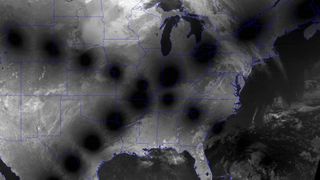Satellite images capture striking differences between the 2017 and 2024 total solar eclipses that swept across North America, including variations in the moon’s shadow along the path of totality.

North America has experienced two transcontinental total solar eclipses within the last seven years, and these satellite images compare the crisscrossing paths of totality.
In 2017, a total solar eclipse moved from northwest regions to southeast areas, sweeping from Oregon to South Carolina and casting a shadow across 14 U.S. states coast-to-coast for the first time in 99 years. Then, just about two weeks ago, on April 8, 2024, another total solar eclipse traveled from the Pacific to the Atlantic, but this time moved southwest to northeast.
Incredibly, the National Oceanic and Atmospheric Administration’s (NOAA) GOES-16 satellite tracked both total solar eclipses from space, documenting the location of the moon’s shadow cast upon Earth in 5- to 10-minute intervals. Recent composite images compare the two solar eclipses and their nearly opposite paths of totality — the brief period of time during which the moon completely covers the face of the sun — that swept across North America.
“The size of the moon’s shadow on the Earth during the total solar eclipses were very different between 2017 and 2024,” officials said in a statement.
The images comprise multiple snapshots of the moon’s shadow as fell across different locations along the path of totality. An overlay of images taken during the two solar eclipses really emphasizes how the paths of totality differed. Satellite imagery was also used to create videos of each solar eclipse, along with a slider image that allows viewers to toggle between composite photos and compare differences observed in the size, duration and darkness of the moon’s shadow between each respective eclipse.
Related: Global ‘time signals’ subtly shifted as the total solar eclipse reshaped Earth’s upper atmosphere, new data shows
The total solar eclipse in 2017 was visible from within a narrow corridor across Oregon, Idaho, Wyoming, Montana, Nebraska, Iowa, Kansas, Missouri, Illinois, Kentucky, Tennessee, Georgia, North Carolina and South Carolina. By comparison, the April 8 total solar eclipse stretched across Mexico, Texas, Oklahoma, Arkansas, Missouri, Illinois, Kentucky, Tennessee, Michigan, Indiana, Ohio, Pennsylvania, New York, Vermont, New Hampshire and Maine, culminating in southeastern Canada.
window.sliceComponents = window.sliceComponents || {};
externalsScriptLoaded.then(() => {
window.reliablePageLoad.then(() => {
var componentContainer = document.querySelector(“#slice-container-newsletterForm-articleInbodyContent-Yvu5QPHTpqAEZ5cYGnZKSW”);
if (componentContainer) {
var data = {“layout”:”inbodyContent”,”header”:”Sign up for the Live Science daily newsletter now”,”tagline”:”Get the worldu2019s most fascinating discoveries delivered straight to your inbox.”,”formFooterText”:”By submitting your information you agree to the Terms & Conditions and Privacy Policy and are aged 16 or over.”,”successMessage”:{“body”:”Thank you for signing up. You will receive a confirmation email shortly.”},”failureMessage”:”There was a problem. Please refresh the page and try again.”,”method”:”POST”,”inputs”:[{“type”:”hidden”,”name”:”NAME”},{“type”:”email”,”name”:”MAIL”,”placeholder”:”Your Email Address”,”required”:true},{“type”:”hidden”,”name”:”NEWSLETTER_CODE”,”value”:”XLS-D”},{“type”:”hidden”,”name”:”LANG”,”value”:”EN”},{“type”:”hidden”,”name”:”SOURCE”,”value”:”60″},{“type”:”hidden”,”name”:”COUNTRY”},{“type”:”checkbox”,”name”:”CONTACT_OTHER_BRANDS”,”label”:{“text”:”Contact me with news and offers from other Future brands”}},{“type”:”checkbox”,”name”:”CONTACT_PARTNERS”,”label”:{“text”:”Receive email from us on behalf of our trusted partners or sponsors”}},{“type”:”submit”,”value”:”Sign me up”,”required”:true}],”endpoint”:”https://newsletter-subscribe.futureplc.com/v2/submission/submit”,”analytics”:[{“analyticsType”:”widgetViewed”}],”ariaLabels”:{}};
var triggerHydrate = function() {
window.sliceComponents.newsletterForm.hydrate(data, componentContainer);
}
if (window.lazyObserveElement) {
window.lazyObserveElement(componentContainer, triggerHydrate);
} else {
triggerHydrate();
}
}
}).catch(err => console.log(‘Hydration Script has failed for newsletterForm-articleInbodyContent-Yvu5QPHTpqAEZ5cYGnZKSW Slice’, err));
}).catch(err => console.log(‘Externals script failed to load’, err));
There were other notable differences, too, including the maximum length of totality, which lasted about 2 minutes and 40 seconds in 2017, but up to 4 minutes 28 seconds in 2024. The width of the path of totality was also vastly different between the two solar eclipses, spanning only 70 miles (113 kilometers) in 2017 compared to a whopping 115 miles (185 km) in 2024. The latter is due to the sun approaching solar maximum later this year.
Originally published on Space.com

READ MORE
What’s the Difference Between Basmati and Jasmine Rice?
Three jars of rice on display: basmati, sushi and jasmine. The rices look similar uncooked, [...]
Best Prepaid Debit Cards
Bluebird by American Express is our top pick overall Prepaid debit cards are an alternative [...]
The Fight Against Ginseng Poaching in the Great Smoky Mountains
Ginseng roots NPS Photo This winter, amid the news of the FBI’s arrest of the [...]
What the Large Penises of Tiny Crustaceans Tell Us About Evolution
Fossil ostracods on a slide from the collection of the Smithsonian’s National Museum of Natural [...]
Scientists and Miners Team Up to Preserve Opalized Fossils
Opalised fossils from Lightning Ridge, N.S.W, Australia. From the collection of the Australian Opal Center. [...]
Ways to synthesize stable diamane at high pressure
Configurations of cubic diamane (a) and hexagonal diamane (b). Credit: Niu Caoping A research team [...]
NASA’s Memorial Honors Lives Lost on the Challenger and Columbia Missions
/ An iconic remnant of the space shuttle Challenger disaster, this flag-covered piece of fuselage [...]
Researchers use structured light on a chip in another photonics breakthrough
Channels for guiding structured light—a prototype of silicon photonic chip with information encoded in the [...]